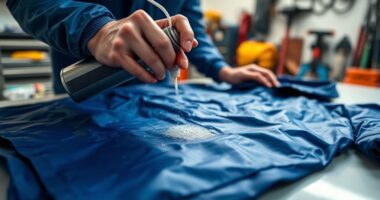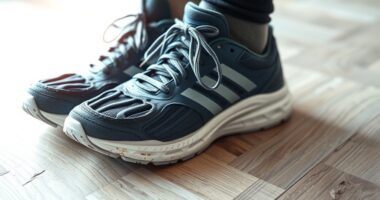Many runners are abandoning traditional shoes after realizing the dangers of heel striking. With high heel-to-toe drops encouraging this harmful technique, it's no surprise that heel striking is linked to higher injury rates. Switching to minimalist footwear can improve your foot mechanics and enhance your overall running experience. These shoes promote a more natural movement, leading to better awareness and potentially fewer injuries. Discover why so many are making the switch and what benefits it could bring you.
Key Takeaways
- Traditional running shoes encourage heel striking, which is associated with higher injury rates among runners.
- Many runners experience discomfort and injuries due to the excessive cushioning found in traditional footwear.
- Switching to minimalist shoes has helped 80% of heel strike runners adopt a forefoot striking technique, reducing injury risk.
- Minimalist footwear enhances sensory feedback, improving foot awareness and promoting a more natural running style.
- The growing trend towards minimalist shoes reflects a desire for better running mechanics and injury prevention among runners.

As more runners discover the downsides of traditional running shoes, many are shifting toward minimalist options that promote better foot mechanics. If you've ever experienced discomfort or injuries while running, you might be part of this growing trend.
Traditional shoes often come with a high heel-to-toe drop, which encourages heel striking. This style of running, while common, is linked to higher injury rates. You may not realize that the cushioned running shoes you've relied on could actually be making things worse.
Research shows that when you wear traditional cushioned shoes, your proprioception—the awareness of how your feet strike the ground—decreases. This lack of awareness can lead to improper foot strike patterns, increasing your risk of injury. If you've ever felt disconnected from the ground while running, it's likely due to the thick cushioning that traditional shoes provide.
You might be surprised to learn that a 2014 study found that 80% of heel strike runners transitioned to forefoot striking after switching to minimalist shoes. That's a significant shift in running mechanics driven by footwear choice.
Minimalist shoes offer reduced cushioning and a flatter design, allowing for better sensory feedback. When you run in these shoes, you'll likely notice improvements in your awareness of foot strike and overall running technique.
Many runners embrace minimalist footwear because they believe it fosters a more efficient running style, enhancing performance while simultaneously lowering the likelihood of injuries commonly associated with heel striking. You may find that this change not only makes your runs feel more natural but also helps in injury prevention. Additionally, some runners find that using a specific kitchen item for preventing blisters, such as a silicone baking mat, can provide extra comfort and protection during their runs. By creating a barrier between the foot and the shoe, it minimizes friction and helps maintain a smooth stride. Ultimately, the combination of minimalist footwear and effective blister prevention methods can lead to a more enjoyable and injury-free running experience.
As you consider making the switch to minimalist shoes, it's essential to give your body time to adjust. The transition can be challenging, but the benefits, including improved running mechanics and reduced injury rates, are worth the effort.
You might start with short runs to allow your feet and legs to adapt to the new style. Embracing a forefoot striking technique can lead to a more enjoyable running experience, one that connects you better with each step you take.
Ultimately, the shift away from traditional running shoes is about understanding your body and the impact of your footwear. By opting for minimalist shoes, you can enhance your running experience, reduce the risk of injury, and embrace a more natural way of moving.
Conclusion
If you're a runner stuck in the traditional shoe mindset, it might be time for a change. Understanding the impact of heel striking can revolutionize your running experience and reduce injuries. By exploring alternative footwear options, you could enhance your performance and comfort. Don't let outdated habits hold you back—embrace new insights and find a shoe that truly supports your natural stride. Your feet will thank you, and your running journey will be transformed.









